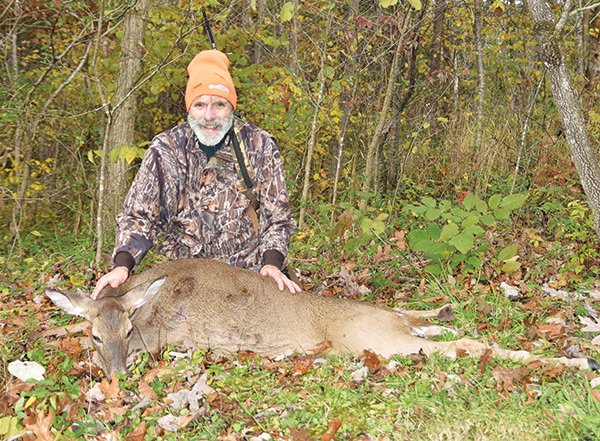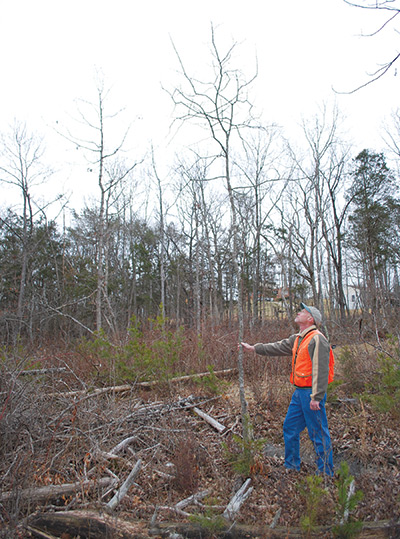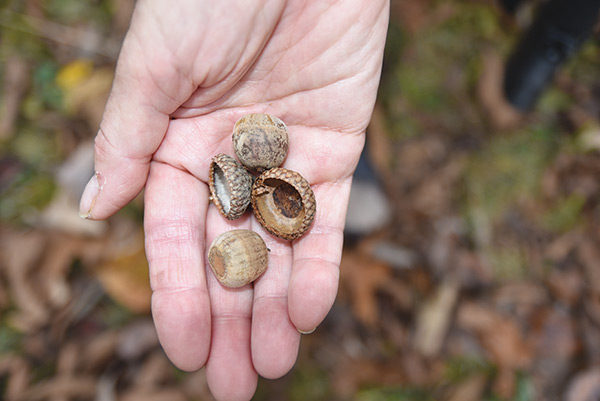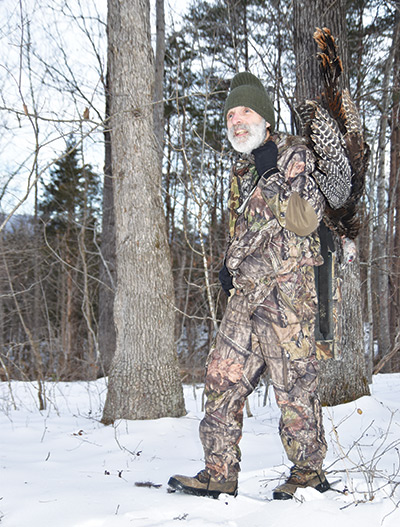 Outdoors: Create Your Own Deer Sanctuary
Outdoors: Create Your Own Deer Sanctuary
By Bruce Ingram

It was the opening weekend of Virginia’s early muzzleloading season, and I had decided to hunt on the 38 acres my wife and I own behind our house. The question was where. My son-in-law, David Reynolds, and his family also live on the land.Together David and I positioned five ladder stands on the property.
After consulting with David on where he’d be going, I pondered the remaining four options. One stand overlooks a hollow full of white and red oaks that had produced a solid crop of acorns. A second ladder stand rests within our clover food plot. The third resides just off our seeded logging road. The trio each obviously had something to recommend them, but I opted for the fourth stand.
That stand lies near our land’s western border. The tote road also winds past it, and two springs and a creek flow behind the stand within the hardwood hollow below. But, by far, the main reason I selected that site was because of the deer sanctuary that David and I have established on the western property line.
With the rut going on, I absolutely knew that both does and bucks would move in and out of this refuge all morning. Does would be heading there to bed or escape bucks; bucks would be checking out the reserve because the does were there. The only question was whether I would wait for a shooter buck or opt for the first mature doe that appeared.

The answer came after less than 20 minutes of daylight. I was perched in the ladder stand. A doe emerged from the sanctuary and began browsing along the logging road. For the longest time I couldn’t shoot because the whitetail was walking straight toward me, but finally she turned broadside. I centered the scope on her vitals and touched off the smokepole. By the time the smoke cleared, the doe had disappeared. But when I descended from the stand and went to where the deer stood, I found a blood trail leading exactly where I thought it would…to the sanctuary. The ample blood trail was easy to follow, and I found the doe just a few yards within the refuge.
A few days later, David enjoyed even more success than I did with the “hunt near a deer sanctuary” strategy. We also have established a sanctuary on the eastern border of the land, and my son-in-law’s favorite ladder stand lies within an easy bow shot of a well-worn trail that leads into the heart of the haven. Additionally, the logging road that runs along most of the property’s perimeter meanders between the ladder stand and the bedding area.
David told me that he climbed into his stand well before dawn, and didn’t have to wait very long for something to happen. Just after daylight, he spotted a mature doe walking the logging road on her way into the sanctuary. David shot and the doe bolted into the refuge. After waiting about a half hour, he descended from the stand, wisely reloaded, entered into the bedding area, and after a short period of time, found the blood trail.
While he was slowly following the trail, he saw a doe up ahead and decided to take her. At the shot, the whitetail immediately collapsed, and David soon realized that this was not the doe he had shot earlier as the blood trail continued past the dead whitetail. Resuming tracking, my son-in-law soon recovered the first doe and with our county’s two deer per day limit, he was tagged out for that outing.
The groundwork for those two successful hunts took place over a series of 10 or so winters — by far the best time for hunters to conduct habitat improvement projects on land they own, lease, or have permission to hunt and improve. The main reason for this time being prime is because the barren landscape allows us to spot game trails, make note of oaks that need to be daylighted, select other trees for removal, and conduct other habitat improvement projects.
Before covering those projects, I should confess to a terrible error I made regarding the deer sanctuary. My wife Elaine and I bought 29 acres of what is now 38 acres in 1988, and we soon realized that the far western side was a major bedding area for deer. The section consisted mostly of 20-year-old densely growing red cedars, scattered Virginia pines and the odd white or red oak struggling to reach sunlight. To the right of the bedding area was a neighbor’s field and to the left a Virginia pine grove.
On opening day of Virginia’s general firearms season in 1988, I killed a young buck (I wasn’t very selective back then) that was heading for the cedar thicket. And as the years passed, I consistently killed deer entering and leaving the copse. But slowly — I now realize inevitably — during that 20-year period I saw fewer and fewer whitetails in that area of my land.

That’s when I decided to take a long, hard, critical look at the area and make note of how time had changed the landscape. Many of the Virginia pines to the left of the sanctuary were dead or dying as this is not a long lived tree species. The oaks within the refuge were not producing many acorns since they still weren’t getting any sunlight. In short, because I had foolishly done nothing to manage the sanctuary and the rest of my acreage, the local deer were not visiting my property as they used to.
Every individual woodlot is in a constant state of slow, subtle changes, some of which will be good for deer and other wildlife, others that make a property less appealing. Then, the negative aspects seemed to outnumber the positive ones.
In 2010, at about the same time this fact occurred to me, the nine acres flanking the eastern side of my property went up for sale. Elaine and I decided to buy the parcel, with the lower half consisting mostly of red cedars bordering the creek, and the upper half containing mostly Virginia pines.
As soon as the purchase of the land was final that winter, I arranged for a logger to cut the pine glades on the western and eastern borders of our property. I also instructed the logger to run the tote road around the perimeter of my land to not only make harvesting the trees easier, but also to allow me to turn the road into a “vertical” food plot of sorts. Additionally, for more diversity, I had him thin a stand of mixed hardwoods halfway between the two borders.
Within a few years, the two former Virginia pine groves had become regenerating clear-cuts that effectively doubled the size of my two sanctuaries. And not only were these two sections of second growth good places for deer to bed, but they also served as areas where whitetails could browse and where does could use to hide their fawns and turkeys could build nests. Similarly, the area daylighted half way between the two sanctuaries became a locale where the surviving oaks produce more acorns and where the opened forest floor provides more forbs and other browse for deer.
Meanwhile, every winter I worked to make the two red cedar stands better for whitetails. I leveled the cedars encompassing a number of white and red oaks in both sanctuaries so that the mast bearers could receive more sunlight. I also hinge cut other cedars and some red maples and redbuds so as to provide more ground cover and create more browse. Additionally, I cut and sprayed such invasive plants as autumn olive and multiflora rose within the two reserves.
All of these habitat improvement projects have, of course, benefitted the local whitetails, but they also have made my land more hospitable to other game animals. Because of the young forest habitat, woodcock stop here late in winter or early in spring to perform their mating rituals. Rabbits are much more abundant, and hen turkeys nest in the cutovers. Indeed, the turkey hunting, like the deer hunting, is much improved.

For example, Virginia has a two-week turkey season in mid-January. In late December last year, I began hearing flocks of mature gobblers sound off some mornings. On other mornings, I often heard a mother hen and her young. Both typically roosted along our hardwood creek hollow below the two sanctuaries. And after flying down, one or both flocks often travelled to one of our sanctuaries.
Having one fall turkey tag left, I could hardly wait until the January season began. One morning, I worked four gobblers at the same time — striking out only because I had to leave for the school where I teach. A few days later, though, school was not in session, and I busted up the mother hen flock, which – unsurprisingly - was feeding through the western deer sanctuary. Because of my daylighting activities, an abundance of Northern red and black oak acorns still littered the forest floor, and the birds were taking full advantage of that circumstance.
The day was bitterly cold and a foot of snow lay on the ground, but I decided that before I gave up hunting for the day, I would wait until I called the young turkeys in or darkness fell. Fortunately, the former took place. I called in and killed a young hen where I had set up just inside the sanctuary… which leads to another point.
David and I stay out of the two deer sanctuaries from August through December of every year, but obviously I have to enter into them every winter to do habitat improvement projects. And I have no worries about hunting within them in January or during the spring gobbler season.
For instance, this past spring before turkey season began, I consistently heard three different gobblers on our land. But when opening day rolled around, I decided to go hunt our 140 acres in adjacent Craig County. I heard a number of gobblers that morning but couldn’t close the deal on any of them. About 9a.m. the gobbling stopped and after not hearing any turkey talk for over an hour, I began to feel that I had made a terrible mistake not hunting behind our house that morning — given all the gobbling I had hear during the preseason.
I packed up, drove home and headed for the western sanctuary, setting up at 10:45 a.m. just inside the refuge where it borders a field. It took all of 10 minutes to convince one gobbler to come toward me, but the old tom hung up and eventually moved away. A few minutes after the longbeard left, another tom answered my clucks and yelps, and he came charging in. I shot him at a distance of just 15 yards.
Establishing a deer sanctuary is not only good for whitetails but also for other wildlife on the land you own, lease or hunt. And if you decide to tag a fall or spring turkey there, well, that’s pretty satisfying, too.